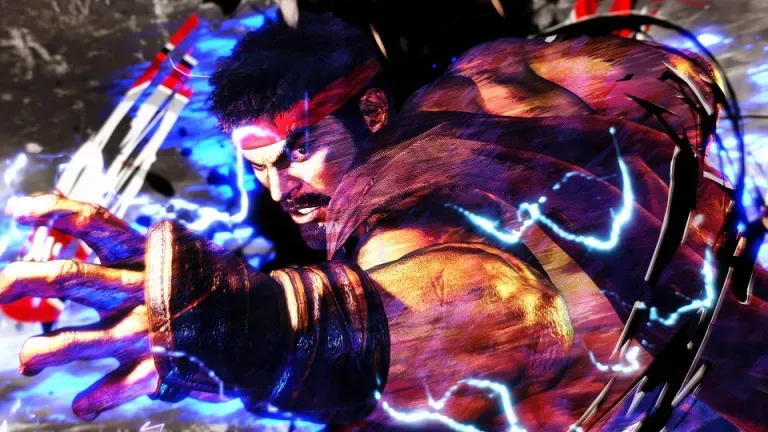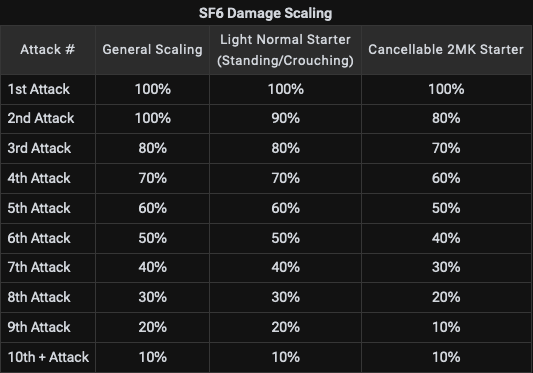How Damage Scaling Holds Fighting Games Together
How damage scaling aids fighting game design by facilitating player expression, balance, and accessibility

Fighting games are, without a doubt, some of the hardest games to develop. Due to their extremely competitive nature, which hinges on micro-interactions, design elements such as clean animations, rollback netcode, clear feedback, and many others become necessities rather than elements of polish. However, in my opinion, the hardest aspect of designing a fighting game is making it feel balanced.
The main reason balancing is so difficult in fighting games is because their appeal comes in the form of player expression. Unlike in linear single-player games where your performance is evaluated by some static algorithm, in fighting games, there is no clear benchmark to reach, since you are tested against endlessly improving human players. The only upper limit to your performance is your own creativity; this is at the core of what makes fighting games fun. As a result, accounting for every possible combo or playstyle in order to ensure balance in a fighting game is a near-impossible feat for developers.
Then how can developers mitigate the possibility of players discovering ways to play that throw the game wildly out of balance? Enter a hidden mechanic that is present in nearly all modern fighting games: damage scaling.
What is Damage Scaling?
Damage scaling is a mechanic that continuously decreases the damage you deal the longer a combo lasts. Some games decrease damage on subsequent hits (such as throughout a single multi-hit move), while others only decrease damage on subsequent player inputs.
Watch damage scaling in action as this 11-hit Juri combo does roughly the same damage as a 69-hit combo while using 2 fewer bars of super.
An 11-hit Juri combo, Source: VesperArcade on YouTube.
A 69-hit Juri combo, Source: desk on YouTube.
Damage scaling also plays several other roles in improving the experience of playing fighting games. In this article, I'll break down the following 4 ways through which damage scaling holds fighting games together:
- More Strategic Gameplay
- Balancing the Roster
- Creating Interesting Decisions
- Lowering the Barrier of Entry
More Strategic Gameplay
Your first thought might be, "That 69-hit combo was so much cooler than the 11-hit one, why are we punishing instead of rewarding players for landing it?"
Take a look at this from the Marisa player's perspective. In most traditional fighting games, hits in a combo past the first one are guaranteed to land as long as the attacking player doesn't make an input mistake. This means that for a full 30 seconds (half of the usually < 1-minute rounds in Street Fighter 6), the Marisa player basically did not get to play the game — they might as well have gone AFK and grabbed a cup of coffee.
Bison's "Touch of Death", Source: rooflemonger on YouTube.
Damage scaling mitigates these "one-player" experiences by making long combos impractical from a competitive perspective on top of their high difficulty of execution. As a result, combos run shorter and players encounter more neutral states, where neither player has the upper hand.
This in turn emphasizes one of the most skillful and strategic elements of fighting games, footsies, where players fight to take the advantage when in neutral. Without damage scaling, we'd have "touch of death" scenarios, like in Street Fighter 2, where many characters had combos that were guaranteed to end a round off of a single favorable neutral interaction.
Even So, Long Combos Are Sick
Maybe you're not convinced. Maybe you're willing to fall victim to a 30-second-long combo because being able to do the same to your opponent makes the wait worth it. Some fighting games, especially tag-team ones, follow this line of thinking, encouraging longer combos by utilizing damage scaling to a lesser degree. However, they often balance this by giving players the ability to break out of combos at the cost of some resource gauge, such as Cross Bursts in BlazBue or Psych Bursts in Guilty Gear Strive.
These additional defensive options cleverly make players feel in control even when falling prey to long combos since they happen as a result of the player's own poor resource management rather than as an extravagant punishment for losing a single neutral interaction.
Psych Burst in GGST, Source: GrowTube TV on YouTube.
Balancing the Roster
Fighting games have long wrestled with creating balanced rosters. Take Marvel vs. Capcom 2 where, if I'm being generous, maybe 10 out of its 56-character roster are ever used in a tournament, versus Tekken 7, where you'll often see bottom-tier characters placing Top 8 at majors. Without a balanced roster, players will, at times, feel that their performance is being limited by their choice of character rather than their skill, which greatly hinders player expression. This also limits the variety of viable playstyles and to a certain degree, wastes the enormous effort developers put into creating different characters.
Some characters in fighting game rosters will inherently not have many combos. This is because although trying to land long combos can be challenging and fun, fighting games provide many other outlets for strategic depth, including movement, okizeme, and anti-airs, among others. This gives rise to character archetypes such as mix-up characters, zoners, or grapplers, who may make up for a weaker combo game with powerful neutral tools or grabs that can take half of your health in one hit.
Damage scaling mitigates the possibility of combo-oriented characters wildly outscaling non-combo-oriented ones in the long run as players discover new combo routes.
Granted, character archetypes like zoners and grapplers often lead to playstyles that some players may find even more frustrating than getting stuck in a long combo, but that's a story for another day.
Source: EVO 2022.
Creating Interesting Decisions
Just because longer combos often are less optimal than shorter ones due to damage scaling, that doesn't mean they are completely unusable. There are situations where players will choose to spend resources inefficiently depending on the state of the game, such as if the opponent is close to a "burnout" in SF6.
This creates interesting risk vs. reward tradeoffs where players will, for example, have to decide between spending all their resources on a long combo that only does marginally more damage with the hope that it will be just enough to finish off their opponent or opt to go for a shorter, safer option but run the risk of not being able to find another opening.
However, combos like the 69-hit Juri combo are a bit too extreme to fit the criteria of high-risk combos, since as I mentioned before, its length scales down damage so much that the 11-hit combo would also have been able to finish off the opponent in the same way while using far fewer resources.
Intense damage scaling in specific situations will also push players to decide how to take advantage of an opening through methods other than dealing damage. After landing a perfect parry in SF6, for example, the damage of your next hit is immediately scaled down by a whopping 50%. At high levels of play, players may use perfect parries as an opportunity to push their opponent into a corner or set up a safe-jump situation rather than opting for a full-damage combo.

Lowering the Barrier of Entry
Damage scaling also benefits fighting games by making short combos not only viable but sometimes even optimal. This means that newer players don't need to master execution-heavy combos before being able to pilot even the most combo-oriented characters effectively.
Here's an example of the exact damage scaling numbers in SF6.

The payoff for mastering a longer combo already begins to drop off beginning with the 3rd hit, making characters' most basic bread-and-butter combos easy to learn, with generally around 3 hits. With the ridiculous skill ceiling and execution difficulty of traditional fighting games, this behavior is very much welcomed.
Developers also frequently apply different damage scaling metrics to specific moves, characters, or situations to have an extra level of control when balancing, as you may have noticed in the perfect parry example before and in the two other columns in the SF6 scaling chart above, which scale combos that begin with low-commitment light-normals or cancellable crouching-medium-kicks to a greater degree. In most fighting games, cinematic supers or ultimate moves will have a damage scaling limit so that they can always serve as satisfying combo enders.
Conclusion
I hope I've been able to show just a bit about how amazing of a mechanic damage scaling is. It is but one part of the intricate web of systems that allows us to experience what we know as fighting games. Seeing how different games implement it and how these small differences affect how the game feels always fascinates me. I encourage you to also pay attention to it when you play!
